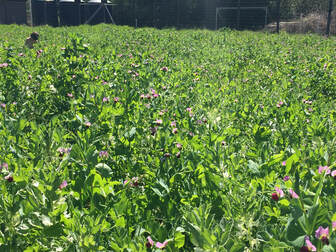April and May Crop Planning for the School Garden
|
Spring Crop Planning Tips for your School Garden
Spring is in full boom and many of us are as busy as honey bees getting our gardens ready for the season ahead. When it comes to planting out our school gardens it is wise to be strategic as to what you want to plant and when rather than letting our spring planting fever take the lead leaving us with an abundant harvest right as the kids take off for their summer vacation. Here are a few suggestions we have for crop planning in your school garden. |
Delay Brassica and Cucurbit Plantings
It’s so easy to plant out our school gardens in a similar fashion to our home gardens without considering some important factors. The first and most important is crop timing. Filling your beds with brassicas like kale, broccoli, cabbage, cauliflower and cucurbits such as squash, cucumbers and pumpkins now will lead to a prolific harvest in June and July with no kids present to enjoy them. Try planting these longer season crops in late July or early August for a harvest in the fall months of October and November.
This idea is relevant to more than just brassicas and cucurbits but should also be applied to any crop with a 70+ day growth cycle.
It’s so easy to plant out our school gardens in a similar fashion to our home gardens without considering some important factors. The first and most important is crop timing. Filling your beds with brassicas like kale, broccoli, cabbage, cauliflower and cucurbits such as squash, cucumbers and pumpkins now will lead to a prolific harvest in June and July with no kids present to enjoy them. Try planting these longer season crops in late July or early August for a harvest in the fall months of October and November.
This idea is relevant to more than just brassicas and cucurbits but should also be applied to any crop with a 70+ day growth cycle.
|
Hold Off on Planting Tomatoes until May
Tomatoes can take quite some time to start producing, depending on your climate, so we recommend waiting to plant them until mid to late May for a harvest that’ll be waiting for you and the kids upon your return in August. The warmer your climate (i.e the further east your are located in the county) the later you can plant them so as to ensure a longer harvest period well into the fall months. |
Turning in your Cover Crops
Before turning in those bountiful fava beans consider leaving a patch to harvest from. One way to choose would be to leave the beans that have already flowered and/or pushed out small pods - chances are these beans will have already used some of that atmospheric nitrogen they fixed in the soil over the winter.
There are many ways to turn in your cover crop but in order to get the most bang for your buck, and keep lots of little hands very busy, simply chop the favas, or cover crop mix, at the base of their stems leaving the root ball in the ground to decompose, and using scissors or pruners cut up the stems into short 2-4” sections to leave on the bed. This method works great if your favas have been growing in individual beds rather than covering a whole field that you’re prepping for planting. If you do have a large field, using a rototiller to turn in the majority of the beans while leaving a small patch for the kids to chop and drop is a great way to go.
Before turning in those bountiful fava beans consider leaving a patch to harvest from. One way to choose would be to leave the beans that have already flowered and/or pushed out small pods - chances are these beans will have already used some of that atmospheric nitrogen they fixed in the soil over the winter.
There are many ways to turn in your cover crop but in order to get the most bang for your buck, and keep lots of little hands very busy, simply chop the favas, or cover crop mix, at the base of their stems leaving the root ball in the ground to decompose, and using scissors or pruners cut up the stems into short 2-4” sections to leave on the bed. This method works great if your favas have been growing in individual beds rather than covering a whole field that you’re prepping for planting. If you do have a large field, using a rototiller to turn in the majority of the beans while leaving a small patch for the kids to chop and drop is a great way to go.
Ways to encourage appreciation of the natural environment this month in the school garden:
1. Have a student weeding workday! Give students an opportunity to truly steward the garden. My experience has been that 4th and 5th graders especially love weeding in teams and using garden tools to remove them. Learning how to remove all of a weed is an important gardening skill and also an opportunity to teach plant parts. “What is a weed?” is a fascinating question! After the giggles from older students, explain that a weed is simply a plant that has adapted very well to the local environment, may be invasive, crowding out other desirable plants or is growing in a place we do not want. Weeds are cultural too - a great example is purslane - considered a weed by most people in California, it is harvested as a highly nutritious green in Latin America. Examine different weeds’ plant part characteristics to get students thinking about the role of each plant part in how the plant survives and thrives.
2. Make artistic flower and plant mandelas in the garden using pieces of plants and nature scavenged from nearby. Make a Nature Mandela.pdf
1. Have a student weeding workday! Give students an opportunity to truly steward the garden. My experience has been that 4th and 5th graders especially love weeding in teams and using garden tools to remove them. Learning how to remove all of a weed is an important gardening skill and also an opportunity to teach plant parts. “What is a weed?” is a fascinating question! After the giggles from older students, explain that a weed is simply a plant that has adapted very well to the local environment, may be invasive, crowding out other desirable plants or is growing in a place we do not want. Weeds are cultural too - a great example is purslane - considered a weed by most people in California, it is harvested as a highly nutritious green in Latin America. Examine different weeds’ plant part characteristics to get students thinking about the role of each plant part in how the plant survives and thrives.
2. Make artistic flower and plant mandelas in the garden using pieces of plants and nature scavenged from nearby. Make a Nature Mandela.pdf


